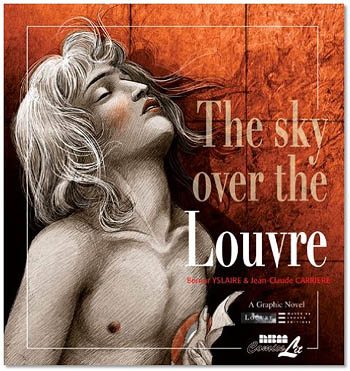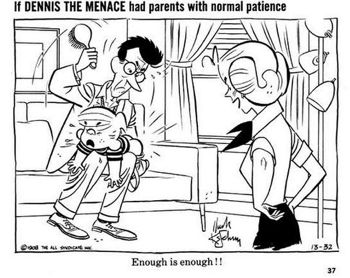They send 'em, I review 'em. Eventually.
 The Sky Over the Louvre
The Sky Over the Louvre
by Jean-Claude Carriere and Bernar Yslaire
NBM
I don't know if you pay any more attention than I do to the seemingly random selection of European comics that NBM brings out, but this is one where attention will pay. In this year that is good God already half over I don't think there's anything in comics that's impressed me more. Like immigrant physics Ph.D.s who must make a living as taxi drivers in the new country, Carriere and Yslaire come before American audience with undeserved anonymity. You will know Carriere better when I tell you he was the screenwriter of Belle de Jour and indeed all of the films of Luis Bunuel's late French period, as well as dozens of others. The Sky Over the Louvre is a story of Jacques-Louis David, Robespierre and the inauguration of the Louvre as a public museum on the eve of the Reign of Terror. David is an idealist in principle and an accommodationist in practice, one who keeps his head while all about him are losing theirs, literally. He maintains his position of privilege, in a studio surrounded by the great works removed from public view because they don't fit the needs of the revolution, because he always does fit the needs of the revolution. Robespierre, who like many a ruler who sets out to reform his people's morals is finding it simpler to kill them instead, assigns David to provide a secular replacement for the gods he means to banish. David tells his young model Jules, "The Republic is ordering an image of virtue from me. I must paint the Supreme Being." "What does that mean?" the young man asks. "I haven't the faintest," says David. Fate and accommodation will both free him of his impossible task and give him a Supreme Being to paint after all. Yslaire can't quite capture the beauty of Jules, who symbolizes the heartbreaking dissolution of the ideals of the revolution, but he can capture just about any sort of human corruption, which is what he needs mouth. The production is marred only by a criminally sloppy job of lettering.
You know, this would make a pretty good movie. Actually, that's not so far out of the question as you might think, seeing as how Winshluss was co-director of the animated version of Persepolis -- or it wouldn't be if there weren't another nasty Pinocchio movie in the works already. But the Winshluss treatment is quite the wide screen epic even on paper, and a steal at $29.95. Winshluss takes the story back to the satirical instincts of Collodi rather than the moral tale assembled by Disney, though Disney is naturally the subject of much of the satire. There's not enough morals in the world Winshluss is depicting to make a moral tale anyway. In this telling Pinocchio is a weaponized robot Geppetto has constructed to sell to the military. By stripping the now mechanical puppet of any personal aspirations it takes the heart out of the story, but Winshluss' treatment is a heartless one anyway. You have the satisfaction of seeing the wicked come to grief because everyone comes to grief, and it's funny because it's not happening to you.
 The Littlest Pirate King
The Littlest Pirate King
David B.
Fantagraphics
Speaking of comics that would make good movies, if Henry Selick is looking for his next project, this is it, right here.
 Reunion
Reunion
Pascal Girard
Drawn & Quarterly
Looking at the Pascal Girard's recent Cartoonist's Diary feature on this website and his latest book Reunion I wonder if Girard's talents might be better served by the picture book format. I suspect his Blechmanesque artwork might have more to gain from room to breathe than it does from sequentiality. His storytelling might flow more smoothly and rapidly with a narrative component to move it along, and I think he writes well enough to pull it off. He might also give some thought to the advantages of fiction. The evidently autobiographical Girard of Reunion resolves to attend his high school reunion, largely to reencounter a high school crush who says she's coming sans boyfriend, but flakes. Now it could be said that this is true to life, but it is true to life in the sense that life is a disappointment and a cheat. Much of the suspense of the story is what she's going to be like and what exactly he intends to do, seeing as he appears to have a perfectly satisfactory domestic arrangement at home. Beyond this he has the same motivation anyone has for going to a high school reunion, to impress people he no longer knows or cares about. To this end he loses 50 pounds through an assiduous program of road work, which is about as amazing as anything I've ever read in Superman. This act of will notwithstanding, he ultimately discovers that a cartoonist's resources are not sufficient to even fake an impression of worldly success. Without an old flame to reencounter Girard attempts to manufacture a narrative payoff from his discovery that he was not the "winner" in high school that he thought. (Mr. Translator, I believe the antonym of "loser" in the high school sense is actually "popular.") This is hardly surprising to the reader, as Girard draws himself as such a shlub (much more so than he looks in photographs). Since to hear them tell it everyone who was not the Homecoming Queen or the captain of the football team thinks they were an outcast in high school, Girard's attitude is at least novel.
 Empire State
Empire State
Jason Shiga
(Abrams ComicArts)
If Jason Shiga could convey human characteristics as well as he could architectural details he'd really have something here. As it is I wasn't even aware that his main character was Asian until he said he was. But then, I couldn't tell by looking whether he or anyone else in the story was young or old, good looking or ugly, well or poorly dressed, or really much of anything at all other than gender. My first impression of his (as it turns out) fully grown characters was that they were elementary school children. If that were not difficult enough, it took me nearly half the book to figure out that the scenes tinted in red were flashbacks and those in the present were tinted blue. Before that I was merely confused. It's a problem that's worth solving because the work has definite qualities. Empire State is an amusing tale that speaks to our sneaking suspicion that people in New York are living better lives than we are. Jimmy, a would-be web designer, content with an existence of comfortable mediocrity in the minor leagues of life, takes a cross-country bus trip to visit his childhood friend Sara who is in New York taking her shot at the majors. Credibility is slightly strained by making Oakland, a place not so terribly far from the major leagues of web designing, stand in for a remote backwater, but never mind. A series of unfolding humiliations brings Jimmy to an ever sharper realization that he is one of those for whom aspirations are not plans but daydreams. Being one of the planning kind Sara cannot know that by inviting him out she is not helping him realize his aspirations but rubbing his nose in his shortcomings. Being more of a Jimmy than a Sara myself I can feel his chagrin. As he is one of the Sara breed, I would encourage Shiga to work on drawing people.
 Krazy Kat & The Art of George Herriman
Krazy Kat & The Art of George Herriman
Edited by Craig Yoe
(Abrams ComicArts)
If it were a comprehensive collection of all the surviving original art of George Herriman it would be called a catalogue raisonné, but not having a particular reason to exist it is subtitled "A Celebration." It would be more aptly called "A Scrapbook." It collects drawings and hand-colored original strips presented to friends, bits of ephemera and the rare and non-Herriman looking merchandising products, reprinted articles from here and there (E.E. Cummings introduction, the Gilbert Seldes essay, &c. &c.), and some interesting family correspondence and photos. (On the theory that he wore a hat to disguise his racial origins, here at least those origins show more with a hat than without one.) As a repository for this kind of material it doesn't serve the purpose nearly as well as the McDonnell, O'Connell and de Havenon Krazy Kat: The Comic Art of George Herriman, but if that isn't enough for you, you can get this one too. The trouble with any anthology that concentrates on the visual side of Herriman's art is that it concerns itself with only half his art.
 Incredible Change-Bots 2
Incredible Change-Bots 2
Jeffrey Brown
Top Shelf
Now that Mr. Family Man has decided to spare his menage the revelation of any juicy stuff, we must get our Jeffrey Brown enjoyment from his more whimsical side. No fair observer would deny that it takes more than one book to fully explore the absurdity of the Transformers concept. (One recalls the story of how Orson Welles prepared himself for his role in the original Transformers animated movie. Standing in a corner of the recording studio with his fingers at his temples, he repeated to himself, "I am giant toy, I am a giant toy . . . ") The flavor might be summed up by the soliloquy of the Change-Bot doctor: "Is that what I'm doing, playing God? Is it ethical to modify and manipulate these Change-Bots? Is it immoral to play God? But if I were God . . . I'd get to decide what's moral or ethical! Back to work!"







